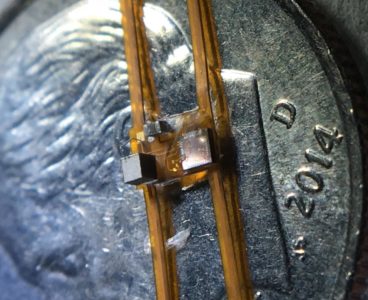Engineers at the University of California, Berkeley have built a new photonic switch that can control the direction of light passing through optical fibers faster and more efficiently than ever. This optical “traffic cop” could one day revolutionize how information travels through data centers and high-performance supercomputers that are used for artificial intelligence and other…
Saturn Hasn’t Always Had Rings
One of the last acts of NASA’s Cassini spacecraft before its death plunge into Saturn’s hydrogen and helium atmosphere was to coast between the planet and its rings and let them tug it around, essentially acting as a gravity probe. Precise measurements of Cassini’s final trajectory have now allowed scientists to make the first accurate…
Researchers Use Gelatin to Make Powerful New Hydrogen Fuel Catalyst
New Quantum Materials Could Take Computing Devices Beyond the Semiconductor Era
Researchers from Intel Corp. and the University of California, Berkeley, are looking beyond current transistor technology and preparing the way for a new type of memory and logic circuit that could someday be in every computer on the planet. In a paper appearing online Dec. 3 in advance of publication in the journal Nature, the…
To Predict the Future, the Brain Uses Two Clocks
Diamond Dust Enables Low-Cost, High-Efficiency Magnetic Field Detection
UC Berkeley engineers have created a device that dramatically reduces the energy needed to power magnetic field detectors, which could revolutionize how we measure the magnetic fields that flow through our electronics, our planet, and even our bodies. “The best magnetic sensors out there today are bulky, only operate at extreme temperatures, and can cost…
New DNA Synthesis Technique Promises Rapid, High-Fidelity DNA Printing
Scientists at the University of California, Berkeley, and Lawrence Berkeley National Laboratory have invented a new way to synthesize DNA that promises to be easier and faster, does not require the use of toxic chemicals and is potentially more accurate. With greater accuracy, the technique could produce DNA strands 10 times longer than today’s methods.…
In Desert Trials, Next-Generation Water Harvester Delivers Fresh Water from Air
Last October, a University of California, Berkeley, team headed down to the Arizona desert, plopped their newest prototype water harvester into the backyard of a tract home and started sucking water out of the air without any power other than sunlight. The successful field test of their larger, next-generation harvester proved what the team had…
Editing Brain Activity With Holography
What if we could edit the sensations we feel; paste in our brain pictures that we never saw, cut out unwanted pain or insert non-existent scents into memory? University of California, Berkeley neuroscientists are building the equipment to do just that, using holographic projection into the brain to activate or suppress dozens and ultimately thousands…
Thin Film Converts Heat from Electronics into Energy
Nearly 70 percent of the energy produced in the United States each year is wasted as heat. Much of that heat is less than 100 degrees Celsius and emanates from things like computers, cars or large industrial processes. Engineers at the University of California, Berkeley, have developed a thin-film system that can be applied to…
New Technology Could Wean the Battery World Off Cobalt
Engineers Build Smallest Volume, Most Efficient Wireless Nerve Stimulator
In 2016, University of California, Berkeley, engineers demonstrated the first implanted, ultrasonic neural dust sensors, bringing closer the day when a Fitbit-like device could monitor internal nerves, muscles or organs in real time. Now, Berkeley engineers have taken neural dust a step forward by building the smallest volume, most efficient wireless nerve stimulator to date.…
Atomically Thin Light-Emitting Device Opens the Possibility for ‘Invisible’ Displays
UC Berkeley engineers have built a bright-light emitting device that is millimeters wide and fully transparent when turned off. The light emitting material in this device is a monolayer semiconductor, which is just three atoms thick. The device opens the door to invisible displays on walls and windows – displays that would be bright when…
Thinning Ozone Layer may have Driven Earth’s Largest Mass Extinction 252 Million Years Ago
Pine trees become temporarily sterile when exposed to ultraviolet radiation as intense as some scientists believe the Earth experienced 252 million years ago during the planet’s largest mass extinction, lending support to the theory that ozone depletion contributed to the crisis. The effect of high UV on conifers and potentially other trees also suggests caution…
Discovery Helps Improve Accuracy of CRISPR-Cas9 Gene Editing
Scientists at the University of California, Berkeley and Massachusetts General Hospital have identified a key region within the Cas9 protein that governs how accurately CRISPR-Cas9 homes in on a target DNA sequence, and have tweaked it to produce a hyper-accurate gene editor with the lowest level of off-target cutting to date. The protein domain the…
Heavily-Used Pesticide Linked to Breathing Problems in Farmworkers’ Children
Scientists Reprogram Embryonic Stem Cells to Expand Their Potential Cell Fates
Researchers from the University of California, Berkeley, have found a way to reprogram mouse embryonic stem cells so that they exhibit developmental characteristics resembling those of fertilized eggs, or zygotes. These “totipotent-like” stem cells are able to generate not only all cell types within a developing embryo, but also cell types that facilitate nutrient exchange…
Genome Engineering Paves Way for Sickle Cell Cure
Seismic ‘CT Scans’ Reveal Deep Earth Dynamics
Changes in Primate Teeth Linked to Rise of Monkeys
University of California, Berkeley paleontologists have identified distinctive features of primate teeth that allow them to track the evolution of our ape and monkey ancestors, shedding light on a mysterious increase in monkey species that occurred during a period of climate change 8 million years ago. The inherited dental features will also help the researchers…




















